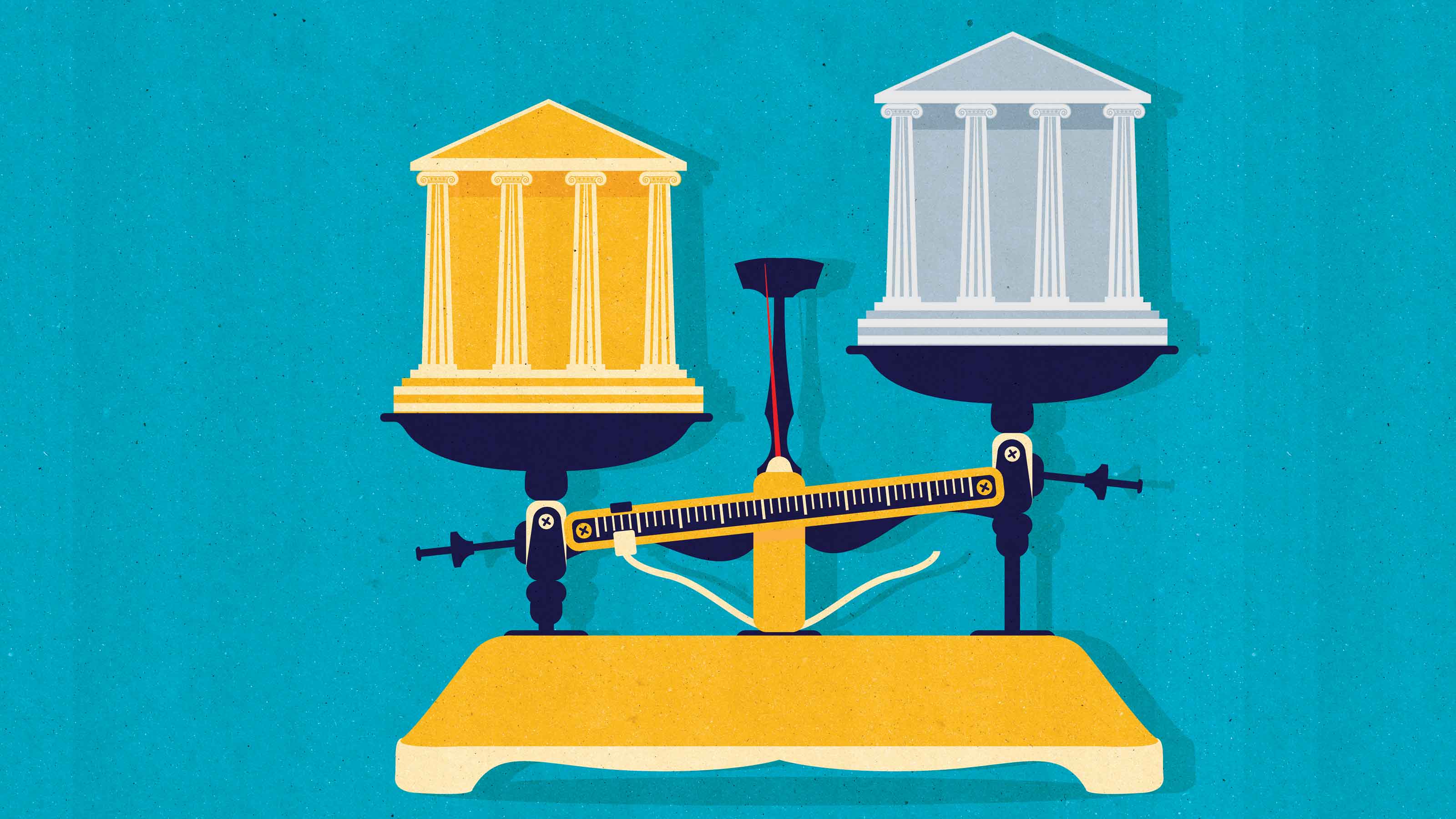Savers Feel the Pain of Low Interest Rates
The Fed's low-rate policy has cost U.S. savers $470 billion.


So much for higher interest rates. When the Federal Reserve finally began nudging up rates last December, long-suffering savers saw a glimmer of hope. But rates on bank savings accounts have remained meager, recently averaging 0.16%. The Fed’s seven-year-long policy of keeping short-term interest rates near zero has meant lean years indeed for savers. A study by the Swiss insurance firm Swiss Re estimates that the Fed’s policy (what economists call financial repression) has cost U.S. savers $470 billion—and that’s after factoring in the effect of lower rates paid by borrowers. Swiss Re calls it a tax on savers and points out that at lower interest rates, older investors need a larger savings base to maintain their spending in retirement.
Savers haven’t been the only ones hurt by low rates. Pension plans, insurance companies and others who depend on making long-term investments to meet future obligations have also been struggling. Swiss Re estimates that insurers in the U.S. and the European Union have forgone $400 billion in income. As a result, companies have had to kick in more money to keep their plans funded (money that might have been used for other purposes), and insurers have been forced to raise premiums or cut back benefits, especially on long-term-care policies and some types of life insurance.
Meanwhile, ultralow rates have been a boon to the U.S. Treasury, which has saved billions of dollars in interest on the government’s considerable debt. Low rates have also helped push up the stock market, spurring yield-starved investors to pile into dividend stocks. In our monthly reader poll, 83% of Kiplinger’s readers told us they own dividend-paying stocks. Around here, dividends is the magic word; we can’t write enough on the subject (see 6 Great Dividend Stocks for Retirees).

Sign up for Kiplinger’s Free E-Newsletters
Profit and prosper with the best of expert advice on investing, taxes, retirement, personal finance and more - straight to your e-mail.
Profit and prosper with the best of expert advice - straight to your e-mail.
This month, we go beyond dividends to take in the full panoply of income investments. In his cover story, associate editor Daren Fonda has turned up opportunities that will pay you as much as 11%. But remember: The higher an investment’s yield, the lower its quality. “Don’t reach too far beyond what you need to meet your goals,” says Daren. “It’s easy to get burned.”
On the safer end of the scale, you can earn up to 4% or more on some bank accounts. But you’ll have to jump through a few hoops, such as making a required number of debit and credit card transactions each month.
Municipal bonds can be compelling if you’re in a higher tax bracket; after taxes, yields on munis exceed those of Treasury bonds with similar maturities. Also attractive are real estate investment trusts. “You can get 4% or 5% without stretching too far into junk territory,” says Daren.
Safety first. Another principle of income investing: Bond prices and interest rates move in opposite directions. So when interest rates rise, bond prices fall. You can protect yourself by buying individual bonds and holding them to maturity, when you’ll get back the face value (assuming the issuer doesn’t go belly-up).
If you choose to buy bond mutual funds, either for convenience or for the expertise of the managers (in the case of risky junk bonds, for example), prices will fluctuate. But that’s of less concern if your goal is mainly to collect income. And if you’re willing to hold the fund for the full interest-rate cycle, the price will recover, says Daren. (Find in-depth coverage of the fixed-income market in our monthly newsletter, Kiplinger’s Investing for Income; $199 for one year.)
Bottom line: Stick with relatively safe investments in your core portfolio, and consider some of the more exotic alternatives to add a little oomph.
Get Kiplinger Today newsletter — free
Profit and prosper with the best of Kiplinger's advice on investing, taxes, retirement, personal finance and much more. Delivered daily. Enter your email in the box and click Sign Me Up.

Janet Bodnar is editor-at-large of Kiplinger's Personal Finance, a position she assumed after retiring as editor of the magazine after eight years at the helm. She is a nationally recognized expert on the subjects of women and money, children's and family finances, and financial literacy. She is the author of two books, Money Smart Women and Raising Money Smart Kids. As editor-at-large, she writes two popular columns for Kiplinger, "Money Smart Women" and "Living in Retirement." Bodnar is a graduate of St. Bonaventure University and is a member of its Board of Trustees. She received her master's degree from Columbia University, where she was also a Knight-Bagehot Fellow in Business and Economics Journalism.
-
 Trump’s Tax Cut Risks Your SNAP, Medicaid Benefits
Trump’s Tax Cut Risks Your SNAP, Medicaid BenefitsTax Cuts The GOP budget blueprint could slash lifesaving programs for millions of U.S. households.
By Gabriella Cruz-Martínez
-
 Can Trump Fire Powell? A Supreme Court Case Could Decide
Can Trump Fire Powell? A Supreme Court Case Could DecidePresidential posts threaten to overwhelm decades of precedent and tradition, whatever the nine justices decide.
By David Dittman
-
 What Does Medicare Not Cover? Eight Things You Should Know
What Does Medicare Not Cover? Eight Things You Should KnowHealthy Living on a Budget Medicare Part A and Part B leave gaps in your healthcare coverage. But Medicare Advantage has problems, too.
By Donna LeValley
-
 15 Reasons You'll Regret an RV in Retirement
15 Reasons You'll Regret an RV in RetirementMaking Your Money Last Here's why you might regret an RV in retirement. RV-savvy retirees talk about the downsides of spending retirement in a motorhome, travel trailer, fifth wheel or other recreational vehicle.
By Bob Niedt
-
 Dividends Are in a Rut
Dividends Are in a RutDividends may be going through a rough patch, but income investors should exercise patience.
By Jeffrey R. Kosnett
-
 Municipal Bonds Stand Firm
Municipal Bonds Stand FirmIf you have the cash to invest, municipal bonds are a worthy alternative to CDs or Treasuries – even as they stare down credit-market Armageddon.
By Jeffrey R. Kosnett
-
 The Best Banks of 2024
The Best Banks of 2024Making Your Money Last Kiplinger's list of the best banks, based on interest rates, fees and other features.
By Lisa Gerstner
-
 High Yields From High-Rate Lenders
High Yields From High-Rate LendersInvestors seeking out high yields can find them in high-rate lenders, non-bank lenders and a few financial REITs.
By Jeffrey R. Kosnett
-
 Time to Consider Foreign Bonds
Time to Consider Foreign BondsIn 2023, foreign bonds deserve a place on the fringes of a total-return-oriented fixed-income portfolio.
By Jeffrey R. Kosnett
-
 The 5 Safest Vanguard Funds to Own in a Volatile Market
The 5 Safest Vanguard Funds to Own in a Volatile Marketrecession The safest Vanguard funds can help prepare investors for continued market tumult, but without high fees.
By Kyle Woodley